How a young farmer is producing pasture-fed, soya-free pork
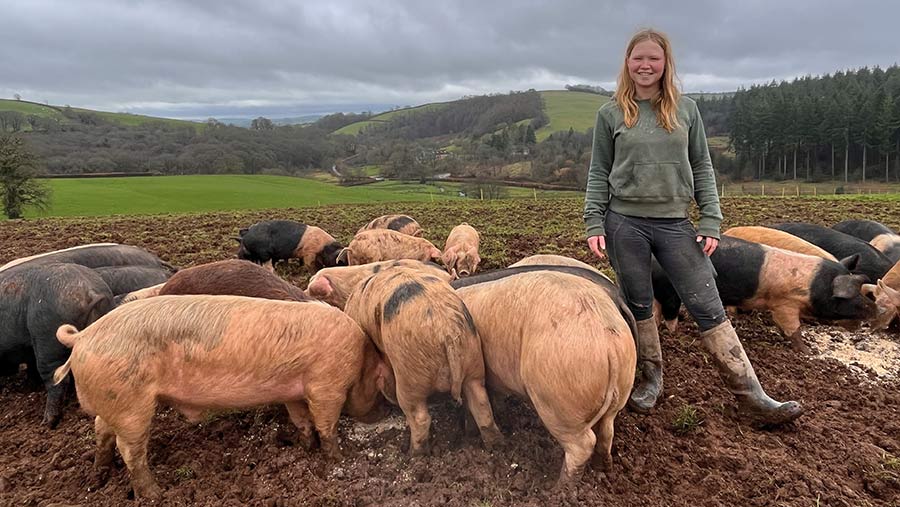 © Hayley Chapman
© Hayley Chapman Feeding soya-free rations to her small herd of outdoor pigs has helped secure Amy Chapple a contract with a London-based meat retailer.
Miss Chapple, who runs her herd at Redwoods Farm near Tiverton, Devon, finishes 140 pigs a year as well as producing eggs from pasture-raised hens.
She sells a few weaners but finishes the majority and transports them to a local abattoir before they are sold direct to consumers or through farm shops and butchers.
See also: Advice for reducing reliance on soya in suckler beef systems
Farm facts: Redwoods Farm
- 61ha (150 acres) owned and about 61ha rented, depending on availability of grazing
- 60 suckler cows, 500 ewes, 3,000 broilers in summer, 150 layers and 10 breeding sows
- Up to 260m above sea level
The Ethical Butcher takes whole carcasses at 70-100kg deadweight and Miss Chapple targets 60-90kg deadweight for her other main customer, Ruxstons Farm Shop, in nearby Wellington.
She operates as a sole trader managing the pig and laying chicken enterprises.
She also takes commission on the beef, lamb and poultry she sells through her online and in-person retail business on behalf of her parents, Mark and Pauline.
They manage the cattle, sheep and broilers and supply The Ethical Butcher with soya-free chicken.
Locally sourced rations
Miss Chapple’s 10 breeding sows are run on a largely outdoor system, with each sow producing two litters a year.
All pigs get the same mix of concentrate, 85% of which is grown within seven miles of the farm. This percentage will increase further as peas are sourced more locally this year.
Their soya-free diet was introduced two years ago when Miss Chapple moved away from a standard pig feed. The ration consists of barley, wheat, beans, peas and rapeseed meal.
The rapeseed meal is sourced from Farrington Oils in Northamptonshire, which achieved carbon-neutral status in January 2020.
“I think the rapeseed meal is an important part [of the ration] because it’s got various amino acids that you don’t find in the beans and peas,” she says.
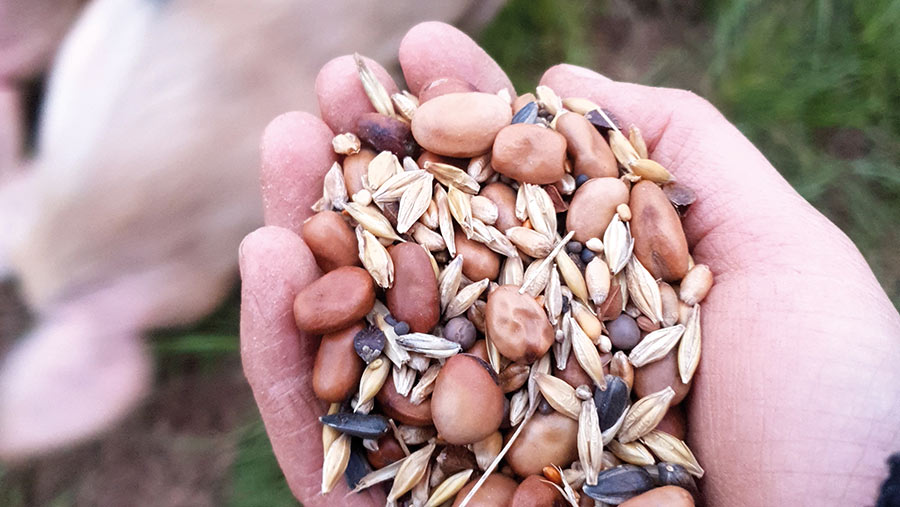
© Amy Chapple
Matching breed to system
Miss Chapple originally started out crossing a Large White with a Saddleback and kept the pigs inside.
However, on moving the system outdoors, those pigs were prone to sunburn, so she moved to mainly Large Black sows and is crossing them with a Gloucester Old Spot boar.
She had to increase grower numbers fast to keep up with demand, so initially bought weaners in, but has now stopped doing this.
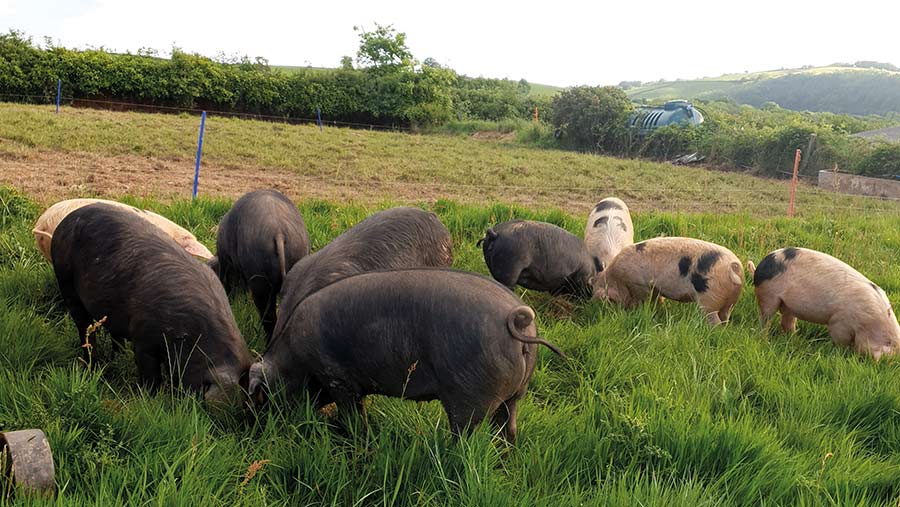
© Amy Chapple
Gilts were retained from the bought-in weaners and have had to prove they can grow well on a mainly forage diet to be selected for breeding.
“I have never wanted to buy sows in. If you can see that they have done well on someone else’s system, it doesn’t mean they will do well on your system,” she says.
The majority of home-bred pigs are now Large Black cross Gloucester Old Spot and gain 1kg in weight for every 3.5kg of feed.
The cross-breeding is key because when the diet was fed to purebred Old Spots, 5.5kg was fed to achieve a weight gain of 1kg.
Boars get an average of 2kg/day and gilts are fed 1.5kg/day – less in summer and more in winter.
One of the health benefits of the regenerative system is that wormers are not required. However, six months ago, some weaners brought in worms, meaning the whole herd needed worming.
This was a contributing factor in her decision to close the herd.
With plenty of stimulation outside, there have never been any cases of tail biting or similar behaviour between pigs, and Miss Chapple believes the system takes pressure off the sows because piglets are busy.
Litters average 9.5 piglets, with an average of nine piglets weaned at eight weeks. Trialling weaning at seven weeks found the piglets were not ready, while extending it to 10 weeks meant the sows were dropping too much body condition.
After weaning, sows are rested for three weeks before being put back to the boar. When Miss Chapple tried putting sows to the boar straight after weaning, they produced two piglets fewer a litter, on average.
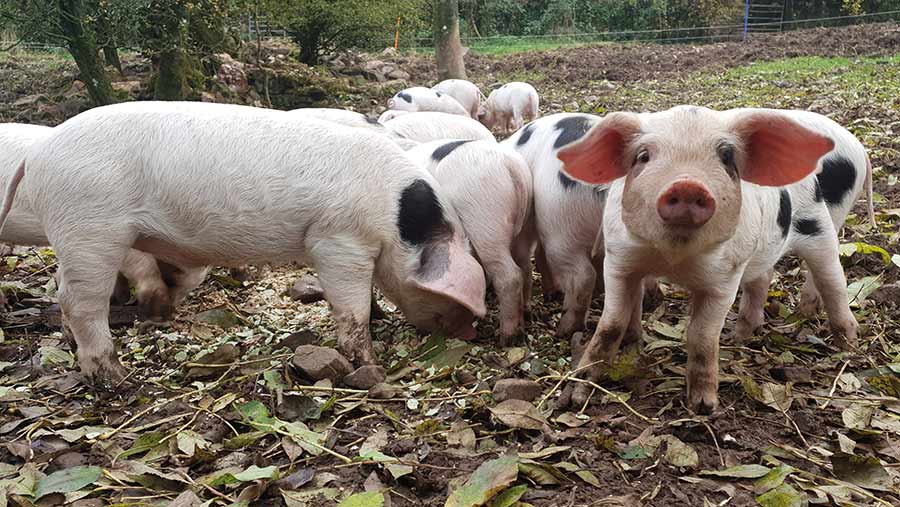
© Amy Chapple
Paddock grazing
During the summer, pigs aged between four and 12 months will be paddock-grazed around a 1ha (2.5-acre) field and a 2.4ha (6-acre) field.
Gilts are stocked at a density of 30 pigs to 0.04ha (0.1 acres) and boars at a density of 40-head to 0.08ha (0.2 acres). Depending on forage availability, they are likely to be moved every three to seven days.
Before pigs leave an area of summer grazing, Miss Chapple reseeds it by distributing a mix of cereals, beans, peas, grasses, herbs, and bird seed by hand.
The pigs dig this in, and the ground is then rested for three to four months.
Miss Chapple believes the natural behaviour the pigs are allowed to exhibit in the system enhances the meat she is producing.
“Because they are moving around more and busy foraging, they build up muscles and it adds a depth of flavour to the meat,” she says.
In winter, when there are fewer pigs, the rotation is slowed down.
“This year I got around the limited winter forage availability by putting some pigs on rented cover crops for winter,” she says.
“The boars are on some grazing that my dad is renting, and they are being used to plough it up before he drills a crop of cereals, peas and herbal ley mix to be cut for cattle silage.”
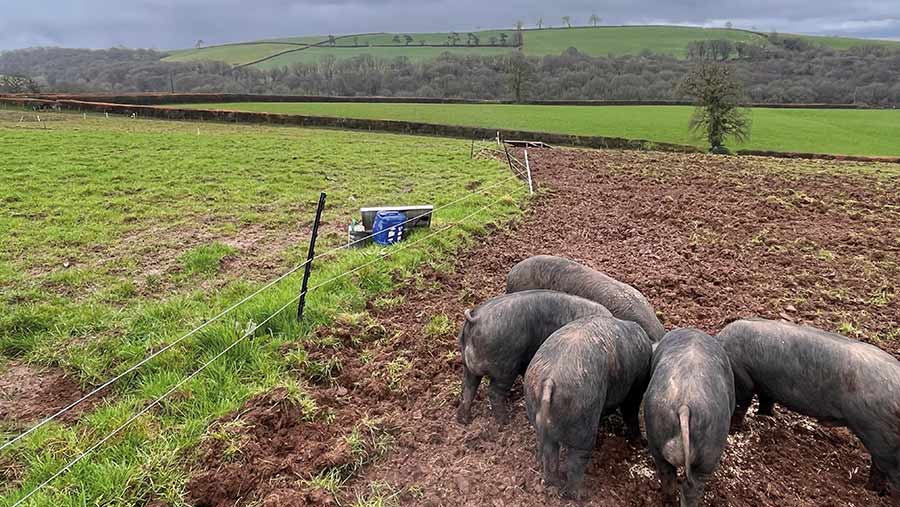
© Hayley Chapman
Pigs as composters
Farrowing takes place in small huts and piglets will be weaned onto pasture. However, in wetter weather, growers are housed in sheds that have previously had cattle in.
The pigs dig and aerate the cattle manure, composting it before it is spread onto grassland.
Miss Chapple scatters wholegrains and beans in the cattle shed every so often before pigs go into the building so that the grains are layered with fresh straw and muck.
“They ferment and smell nice, so the pigs go digging,” she explains. The composting of the manure makes the nutrients more readily available when it is spread on the grassland.
Soil testing has not been carried out at the farm, but is something Miss Chapple would like to do, to monitor the effects of the grazing system and species planted in the pig rotation.
She would also like to introduce some native cattle, such as Longhorns, and mob-graze them ahead of the pigs to increase animal impact.
“We [the farm as a whole] haven’t used fertilisers or pesticides for more than five years. We qualify for organic in a lot of ways, but because of the rented grazing, we cannot be certified as organic,” she says.
